ASAU students design and build a community fridge and pantry in Ottawa
October 10, 2022
A new service to help address food insecurity, called Public Foods — Your Community Fridge and Pantry, has opened in Ottawa’s Centretown in a structure designed and built by students from the Azrieli School of Architecture & Urbanism.
The master’s students designed the small building at 415 MacLaren Street through Assistant Professor Menna Agha’s elective seminar course, Architecture of Community, and built it this past summer.
“It was three hard months of work by the students,” Dr. Agha said at the October 6 opening, attended by about 60 people, including neighbours and representatives of project partners, Ottawa Community Housing (OCH) and the Glebe-St. James United Church.
“We work under the (school’s) Architecture Action lab, which means we are there to serve the community and have architecture students employ their skills and be part of community service,” she said.
The result is a handsome building that acts as an outdoor cupboard and fridge. The fridge and shelves open to the exterior under a sheltering roof overhang. A cheerful mural animates the sliding door of the pantry while another door opens to the fridge.
Unlike food banks, it is accessible 24/7. People are invited to “take what you need, leave what you can.” On opening day, it contained dairy, fruit, vegetables, eggs, and dry goods such as pasta and peanut butter.

CBC Coverage
Watch a report on the opening, starting at 20.47.
https://www.cbc.ca/player/play/2081639491796/
Listen to a report on the construction here. Read the story here.
“This was such an amazing opportunity to learn not only about caring for the community as designers and fellow community members but also get hands-on construction experience,” said Hilary Romaniuk, one of the student volunteers.
“This practical experience is something that is rare in Canadian schools of architecture.”
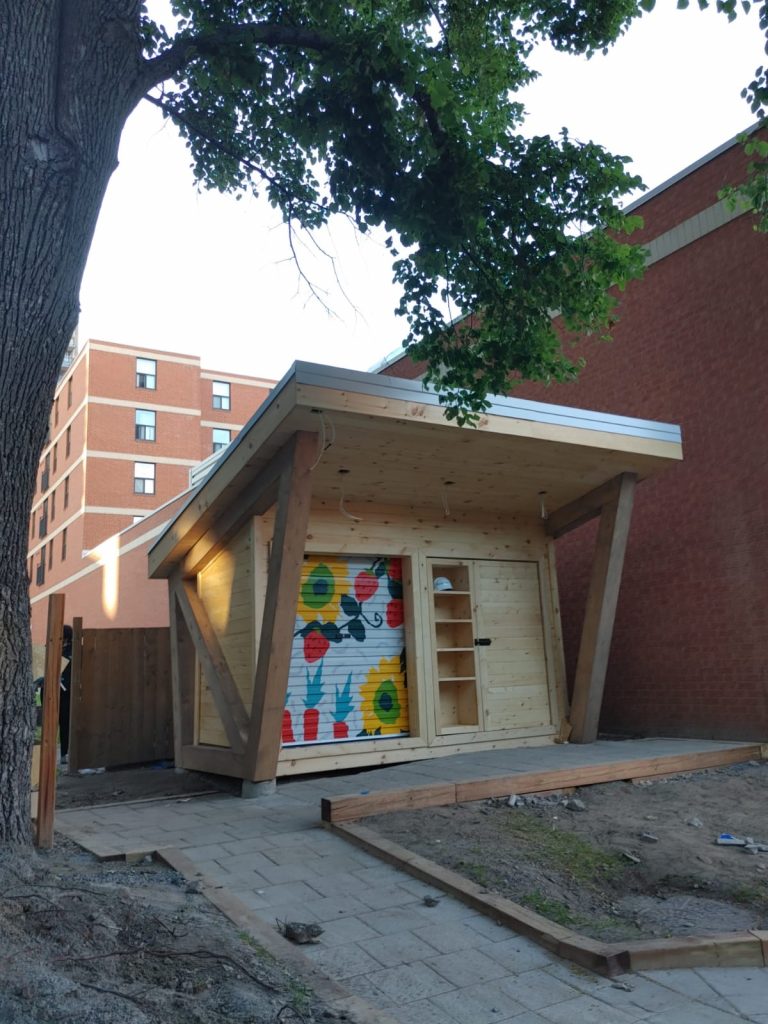
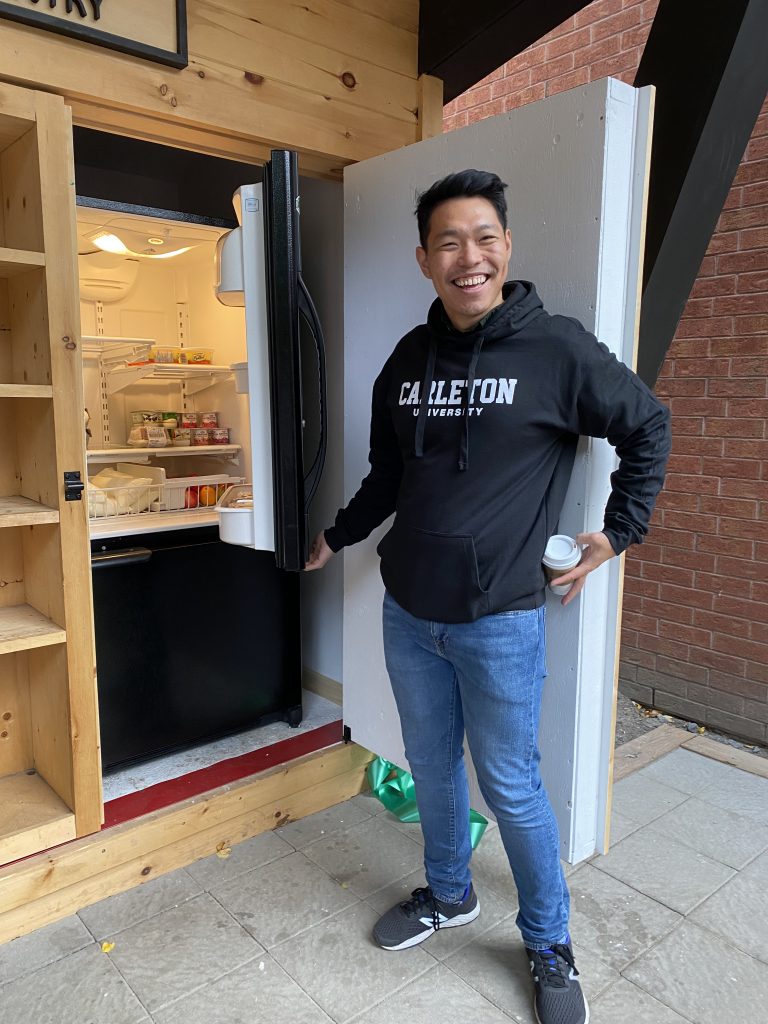
On a typical summer weekend, when construction was underway, there were up to 12 students assisting. Overall, about 30 participated, with a core group comprised of Thompson Nguyen, Sally El Sayed, Hilary Romaniuk, Josh Eckert, Arkoun Merchant, Susan Chung, Lauren Liebe, and Minette Murphy.
The project is the first of the new Architecture Action Lab, a public-interest experimental studio initiated by Agha. It aims to be an ‘imaginarium’ for community change and impact by positioning architects as activists who provide architectural, planning, and housing services to community groups.
In speaking with the CBC, which covered the construction and the opening, Agha asked: “How do we design for people who usually cannot afford design help or afford to hire or commission us?”
The answer was provided by students who gave their time and enthusiasm to realizing the project.
“Our small seminar class made many iterations of the community fridge and pantry design and got community feedback throughout the process,” explains Romaniuk. Students researched the area around the site and met with nearby residents and community partners who supported the endeavor.
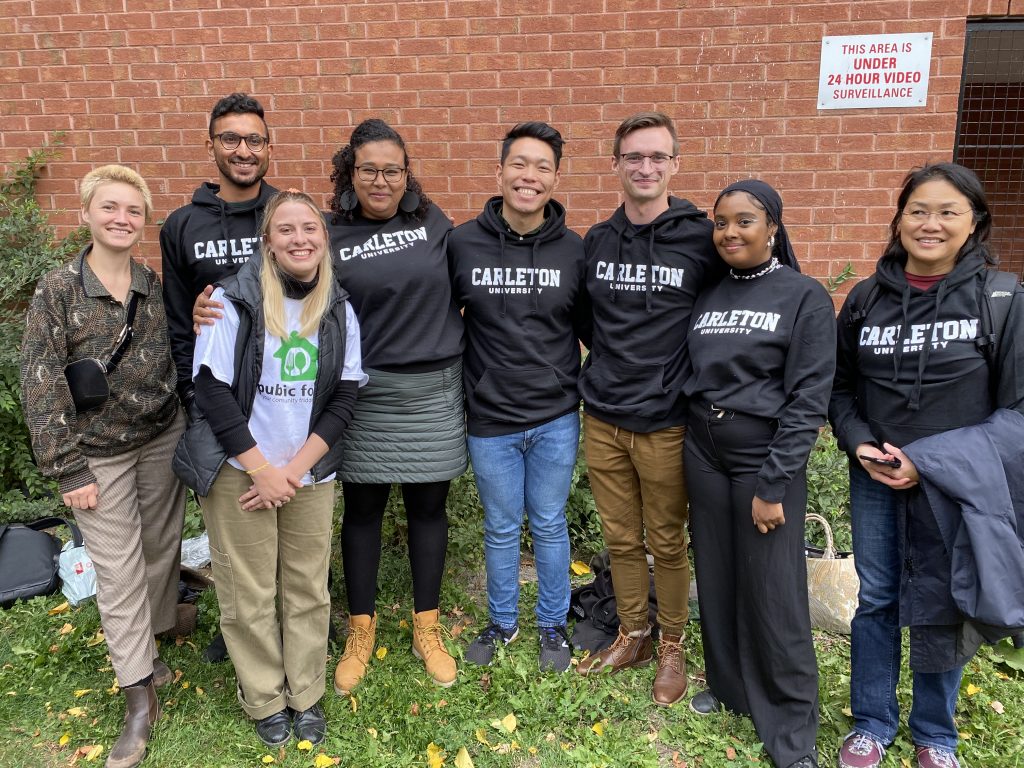
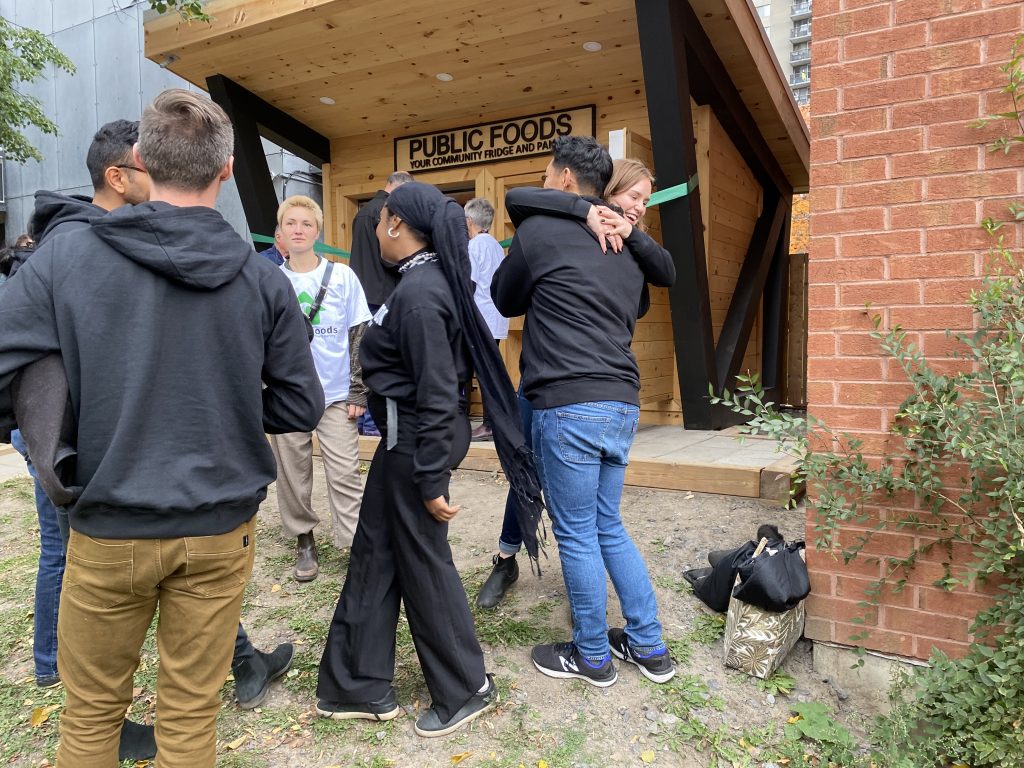
The site also had a disability audit, which looked at everything from the ramp to the colours of the planned mural.
“It was important to us to design a beautiful and high-quality pantry because many of the important users of the pantry are often neglected and underserved,” she says.
Josh Eckert, in his second year of the Master of Architecture program, led construction on site. He is experienced in building and shared his knowledge with the student volunteers.
“I was teaching them carpentry, teaching them how to create the pavers, making all of the interesting little construction details that they’ve drawn a dozen times but never actually had the hands-on experience with.”
Robust laminated pressure-treated lumber trusses support the floor and roof and sit at four points on concrete footings. The structure containing the fridge and pantry is five-feet deep, twelve-feet-six-inches long, and eleven-feet high. It is mostly made of pine. People can approach using an accessible walkway.
Sally El Sayed, who graduated from the Master of Architecture program last spring, found the experience rewarding. “It really helped me learn how buildings fit together,” she says. “You learn about it in school abstractly. You know what those drawings look like, but on-site, you see how those things fit together.
“I’m so relieved and excited that it’s done,” she added. “There are so many residents who came by who said that this was helpful for them.”
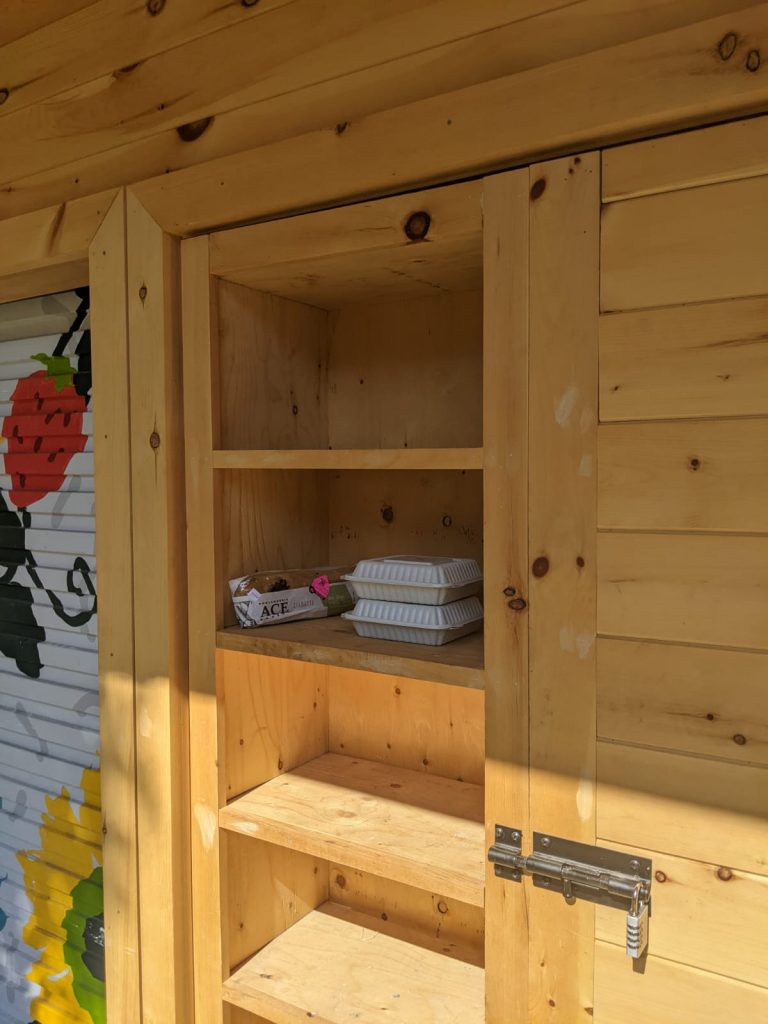
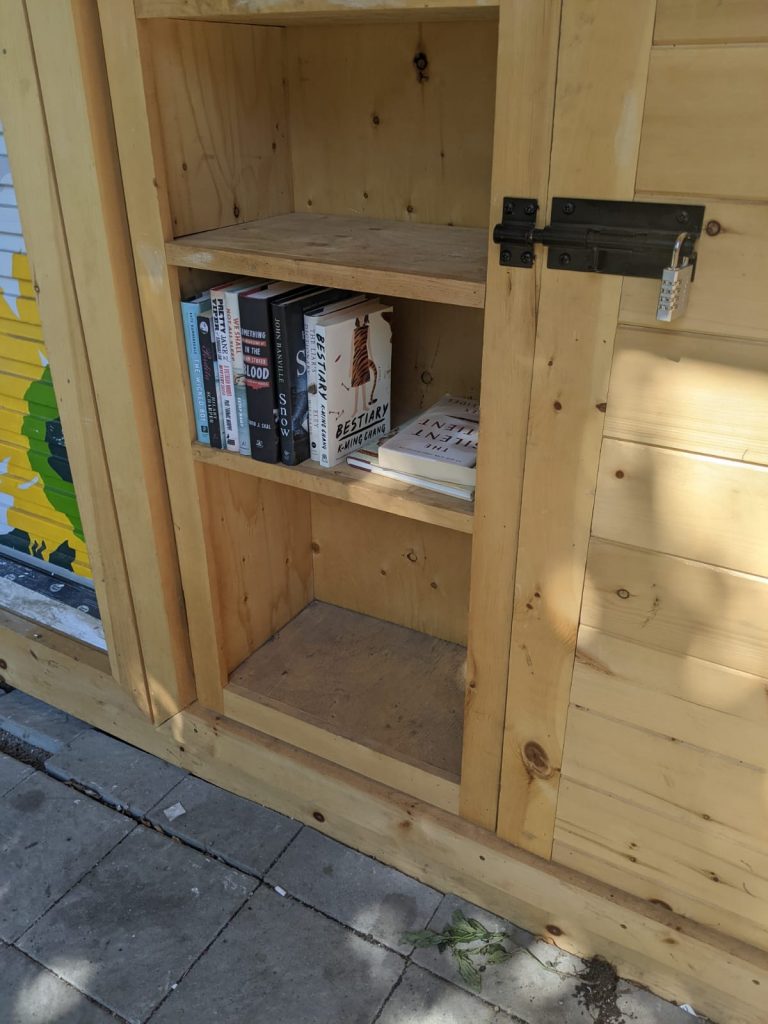
Unfortunately, vandals destroyed a vertical herb garden that was part of the design in August. So, for the opening, the students replaced the herb boxes with pots of chrysanthemums for a splash of colour.
The biggest challenge, however, proved to be the summer’s historic thunderstorm with winds up to 190 km/h.
When the wind and rain began unexpectedly on Saturday, May 21, the project was into construction with frames half completed and concrete that was supposed to be settling.
“I had to put my students in (the next-door apartment building) and watch our construction be destroyed by the storm in front of our eyes,” recalls Agha.
“We just ran in and locked the door and looked out the window and saw the storm destroy the site,” she says. “When the storm came it threw away anything that was vertical. It threw away completely the concrete work that we were doing that day.”
Construction resumed after the storm. “We were devastated, but we just came back and worked,” says Agha. “It’s the comeback story that we have in architecture. You just start over and get it up again.”

The budget was established with $15,000 from the university’s Faculty of Engineering and Design that Agha had previously allocated for a design-build project.
A GoFundMe campaign by students raised $1,000. A further $10,000 came from donations and heavy discounts from suppliers such as Home Depot, The WoodSource, and Ottawa Valley Metal, facilitated by employees who were Carleton University alumni.
“I’m in awe of the amount of community outreach that Menna and the team were able to do in a short time,” says Romaniuk. “Through lots of labour and generosity of wonderful partners, we were able to secure funding and material donations necessary for completing the project.”
The idea for the community fridge and pantry originated with the Glebe-St. James United Church. Volunteers from the church will help operate the pantry, and the church will actively seek donations to fill the shelves.
Agha learned of the project from an invited speaker to her class from the Centretown Community Health Centre.
Arlington 5 Café donated the fridge, and Ottawa Community Housing provided the location and power to the structure.
There are 528 residents in the two OCH buildings neighbouring the structure, of whom 236 live alone. The average monthly income of the residents is $1,413 per month.
“We know that a lot of times tenants face financial challenges that leave them choosing between bills and groceries,” says Brian Gilligan, chief officer of OCH Community and Tenant Support.
“Food insecurity is a real issue in Ottawa, and this is a tangible way of moving forward.”
Federica Goffi, interim director of the Azrieli School of Architecture & Urbanism, congratulated the students on a successful launch.
“I have been truly impressed by the selfless and indefatigable work of the student volunteers led by Dr. Menna Agha in the Public Foods project,” says Dr. Goffi.
“This work goes well beyond an academic exercise to effect real change in our communities and expresses to the fullest the intent of the lab recently founded by Dr. Agha, the Architecture Action Lab.”